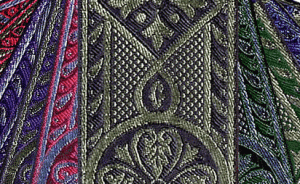Many people are confused by the different terms when trying to purchase fabric trim online. There are some terms that are interchangeable and some just sound like they are from outer space!
We at Athena’s Grove feel that this kind of confusion takes away from the joy of shopping and creating, so we have provided this list of common fabric trim industry terms for you.
Appliqué: An embellishment that incorporates embroidery and fabric. A backing is applied which can be heat sensitive for ironing, or pressure sensitive for press-on. Used as a motif type trim on any type of garment.
Beading: A lace or embroidery which has slits through which ribbon may be drawn. Used as a top trim.
Box Pleat: A fabric, ribbon or lace pleated to form a box, bound together at the top. Because of its unique take up, this trim can be used anywhere you would use a full ruffle. Turns corners easily. Can be inserted in seams or glued on craft projects.
Braid: A braid is three or more separate strands of material interwoven or twined in a diagonally overlapping pattern. Simple braids with more than three strands can be flat or tubular and generally contain an odd number of strands.
Butterfly Pleat: A fabric or lace pleated in a series of varying widths held together with center stitching. Used in the same manner as the box pleat.
Chain: A mock metallic link chain. Used as a belt or as an accent trim.
Cluny: A coarse crochet type lace, typically of 100% cotton. Used as an edging in a seam or at a hem, sleeve, pillows, craft projects. Can be glued or sewn.
Combination: Term applied to more than one type trim or ribbon in combination.
Cord/Cording: A cord can be made by twisting, knitting or braiding. A twisted cord has 2, 3 or 4 plys which can be made of different colors or fibers. Braided and knitted cords are tubular with, or without a filler. Silky cord is an example of a braided cord. Used as a drawstring or a top “trim”; may be sewn on garments in a passementarie style, as an edging for home decorating items, craft projects; may be sewn by machine or hand, or glued.
Crystal Pleat: A fabric or lace pressed into accordion type folds. Used on bridal garments as an insertion into the seams at hem and at sleeves.
Double Ruffle: Two edgings which are gathered together. Used around sleeves, necks and hems of garments and as a trim on home decorating pillows and curtains. Usually applied into the seam.
“E” Loop, Double “E” Loop: A braided trim with loops along one or both edges. Used as a top trim; can be sewn or glued.
Edging: A lace or embroidery which has one decorative edge and one straight (raw) edge. Used as a decorative edge, always sewn into the seam.
Embroidery on Sheer: An edging that uses a sheer base fabric. Can be used as any ruffle or edging.
Eyelet/Embroidery: A fabric which has holes punched and stitching (embroidery) applied to create a design. Can be used as any other ruffle, edging or beading as a top trim or applied into the seams.
Fold Over Braid: A braided or knitted band folded slightly off center used as a binding. Used as a finish, sandwiched over a raw edge.
Frog Closure: A two-piece closure made of cord that is decoratively wound. One half contains a loop and the other a knot. Used as a closure instead of buttons, or as a decorative item. “Togglers” are fun frogs for children’s garments.
Fur: A knitted fabric simulating different fur types, usually machine washable acrylic.
Galloon: A lace or embroidery which has two decorative edges. Used as a top trim on garments and home dec projects.
Header: A second lace or embroidery that is sewn to the first to create a second decorative edge. Used as a top trim on projects; can be sewn or glued.
Heat Transfer: A technique used to transfer colors from paper to a variety of laces or trims.
Lace: An openwork fabric of threads forming decorative designs. Used in many of the above executions as a fabric trim.
Lizard Stitch Braid (Double Pleat): A fabric or ribbon pleated along both edges to create a scale like surface. Used in the same way as an end or top trim.
